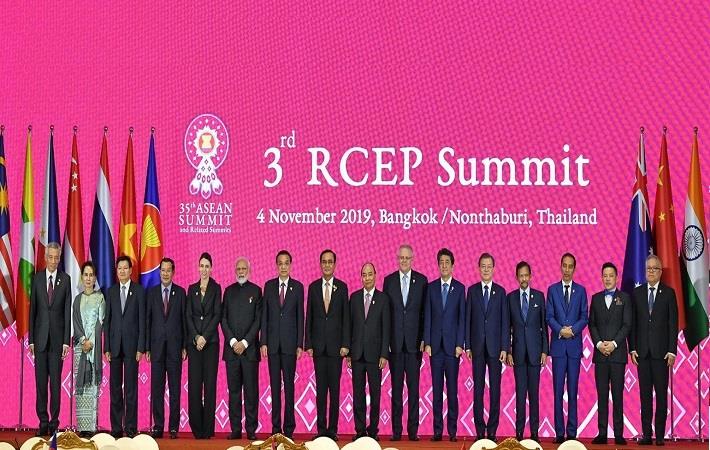RCEP fallout: India desperately needs a new trade policy

By Subir Ghosh
India's decision to pull out of the Regional Comprehensive Economic Partnership (RCEP) is bound to go down well on the domestic front. But, on the trade front, things might just go out of hand. Unless, it recalibrates its Foreign Trade Policy.
India's decision to exit the bloc came after Prime Minister Narendra Modi highlighted during the Bangkok round of talks this week that he was concerned over the impact it would have on lives and livelihoods of Indians, especially farmers. Many had seen this coming in the wake of the opposition to the pact that had been building in the country over the last few weeks.
"We took the right decision to not join the RCEP in national interest. India participated in the RCEP in good faith and negotiated hard. India has significant core interests that remain unresolved," the ministry of external affairs said in a statement.
But concern for farmers does not appear to be the only reason behind India's decision to exit the China-backed trade bloc that was expected to cover roughly one-third of the global economy. The biggest apprehension was that India would be forced to cut duties on 90 per cent of goods being imported over the next decade or so. These included steel from China and dairy products from Australia and New Zealand.
India had also wanted a protection mechanism to be built into the partnership as a safeguard against any sudden inflow of goods after the pact came into effect. The well-grounded apprehension was this: China has been looking for new markets in the aftermath of its ongoing trade war with the United States (US). Many industry sectors in India had been arguing that the RCEP would pave way for Chinese companies to dump their goods in the face of a trade slowdown on the US front.
Of the 16 negotiating countries, India would have been the biggest single market for Chinese companies desperate to offload stocks. One textile trade association even felt that about $50 billion worth of finished fabric stock could be dumped in India had the country gone ahead with the deal.
India had also opposed 2013 being used as the base year for reducing tariffs and instead made case for 2019, particularly since import duties on goods like textiles and electronic items have gone up since 2013. This remained a sore point till the end.
The run up from the RCEP
It would make sense to delve briefly into the background.
When China began growing at a phenomenal rate during the global financial crisis of 2007-08, the US administration under President Barack Obama began looking for ways to stop the Chinese juggernaut. What began as negotiations over trade liberalisation of financial services with the TPSEP (Trans-Pacific Strategic Economic Partnership agreement or Pacific-4 among Brunei, Chile, New Zealand and Singapore) soon morphed into the Trans-Pacific Partnership (TPP). The talks progressed in secrecy and opposition to the deal gathered steam in most of the negotiating countries.
The counter-move from China came in November 2011 when the RCEP was introduced at the ASEAN Summit. Talks, however, began only in 2013. By the time the fifth round of talks could begin in June 2014 in Singapore, India had already seen a change of guard in New Delhi.
The TPP came a cropper once Donald Trump pulled out of the deal as he had promised to do if elected President. A watered-down version of the TPP (minus the US) went on to become the TPSEP all over again, and the RCEP became the focus of all attention. In over 20 rounds of RCEP talks (since mid-2014), it was the current regime that had represented India. Incidentally, the 27th round of talks were held in China this July, and the Bangkok meeting from October 31 to November 3 was a leaders' summit that was slated to announce the finalisation of the deal that would be signed in February 2020.
It is a different matter altogether that the US commerce secretary had recently described the RCEP as a "very low-grade treaty." What happened in the meantime was the full-scale trade war between the US and China, and hence the latter's frantic moves to push the deal through.
But, where does this leave us?
The world order is no more what it was when the Foreign Trade Policy (FTP) 2015-20 was announced. India will need to make a lot of course corrections if it has to look at export-oriented growth. Thankfully, the current FTP ends next year.
It would be interesting to note the progress that India has made since 2015 on the trade front: virtually nothing worth note.
Negotiations over a free trade agreement (FTA) with the European Union has been deadlocked for years. The government has not been able to break it by any measure, and Brexit has only made matters worse. Things are way too fluid. In the interregnum, Vietnam grabbed a lucrative deal with the EU. This was a double blow. Not only was Vietnam able to steal a march over India, the latter still does not know how to seal a deal.
As things stand, India would continue to trade with the ASEAN bloc, but with those countries now part of the RCEP grouping, it would be interesting to see if conflicts of interest arise in the days to come. For the record, India had a trade deficit with 11 of the 15 other negotiating countries, not to speak of the $53 billion trade deficit that India still has with China.
India needs to formulate a new FTP. Real fast.
Fibre2Fashion News Desk (WE/SG)
































-Ltd..jpg?tr=w-120,h-60,c-at_max,cm-pad_resize,bg-ffffff)





.jpg?tr=w-120,h-60,c-at_max,cm-pad_resize,bg-ffffff)
.jpg?tr=w-120,h-60,c-at_max,cm-pad_resize,bg-ffffff)






